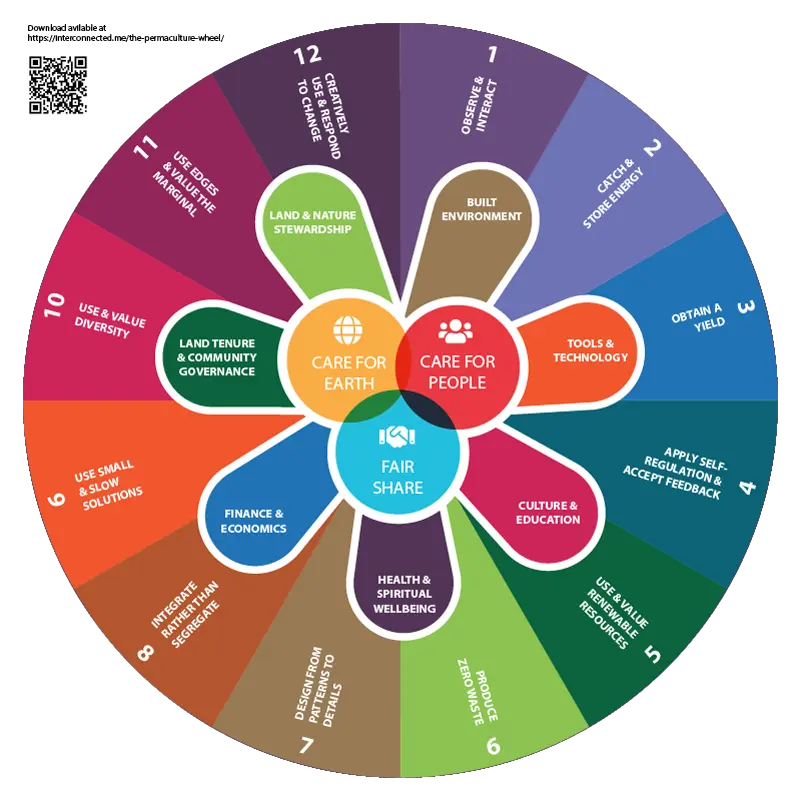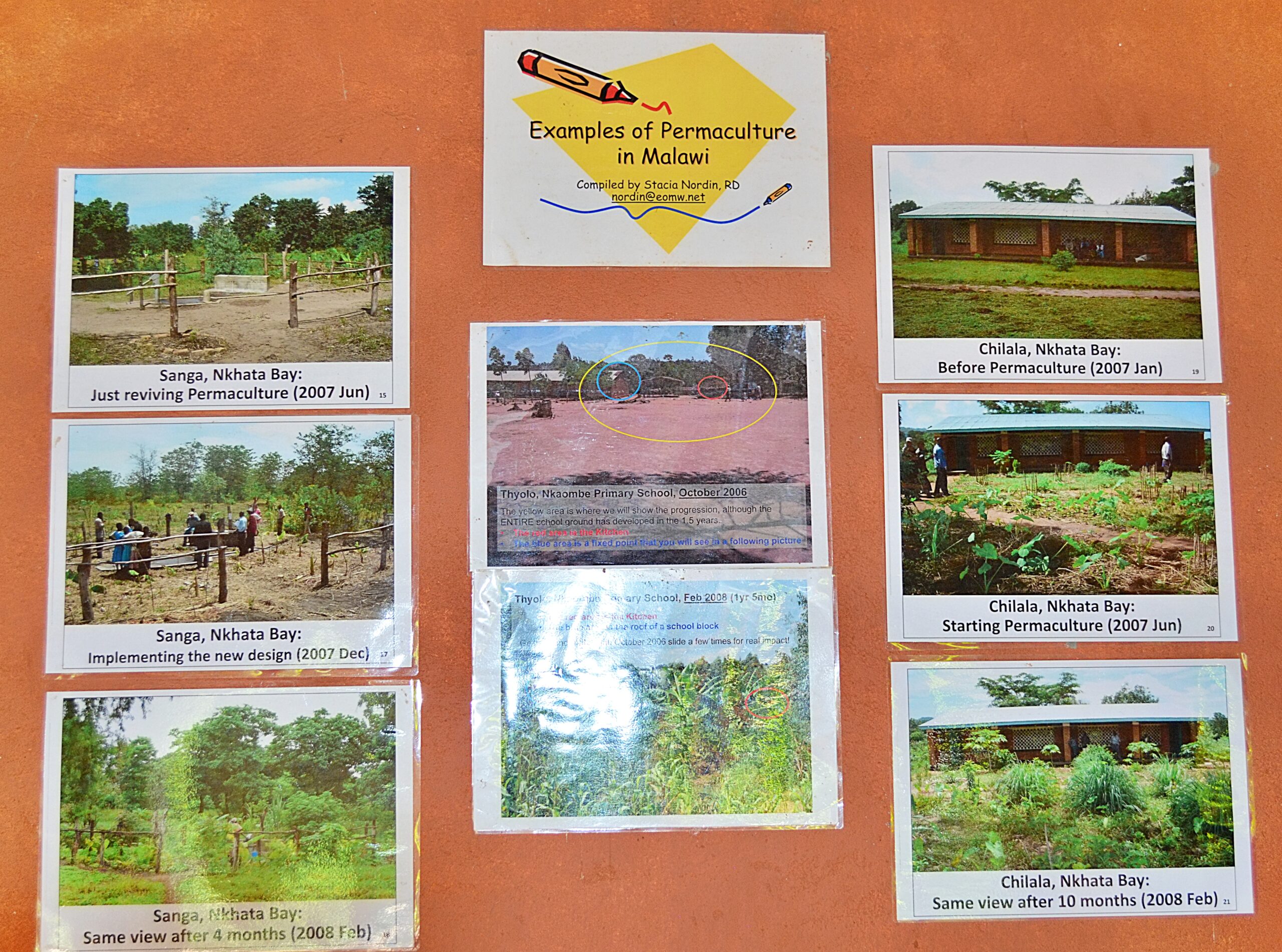
Permaculture is based upon principles and ethics. Ethics help us to choose between right and wrong, whereas principles tend to give guidance on decision-making and strategies. In Permaculture, principles help to guide the process of design.
When Permaculture was first established by Bill Mollison and David Holmgren, they devised a rather extensive list of principles to help practitioners design for sustainability. This original list included 35 different principles and are as follows:
Mollison Principles:
- Relative Location: Components placed in a system are viewed relatively, not in isolation.
- Functional Relationship between components: Everything is connected to everything else.
- Recognize functional relationships between elements: Every function is supported by many elements.
- Redundancy: Good design ensures that all important functions can withstand the failure of one or more element. Design backups.
- Every element is supported by many functions: Each element we include is a system, chosen and placed so that it performs as many functions as possible.
- Local Focus: “Think globally – Act locally” Grow your own food, cooperate with neighbors. Community efficiency not self-sufficiency.
- Diversity: As a general rule, as sustainable systems mature they become increasingly diverse in both space and time. What is important is the complexity of the functional relationships that exist between elements not the number of elements.
- Use Biological Resources: We know living things reproduce and build up their availability over time, assisted by their interaction with other compatible elements. Use and reserve biological intelligence.
- One Calorie In/One Calorie Out: Do not consume or export more biomass than carbon fixed by the solar budget.
- Stocking: Finding the balance of various elements to keep one from overpowering another over time. How much of an element needs to be produced in order to fulfill the need of whole system?
- Stacking: Multilevel functions for single element (stacking functions). Multilevel garden design, i.e., trellising, forest garden, vines, groundcovers, etc.
- Succession: Recognize that certain elements prepare the way for systems to support other elements in the future, i.e.: succession planting.
- Use Onsite Resources: Determine what resources are available and entering the system on their own and maximize their use.
- Edge Effect: Ecotones are the most diverse and fertile area in a system. Two ecosystems come together to form a third which has more diversity than either of the other two, i.e.: edges of ponds, forests, meadows, currents etc.
- Energy Recycling: Yields from system designed to supply onsite needs and/or needs of local region.
- Small Scale: Intensive Systems start small and create a system that is manageable and produces a high yield.
- Make Least Change for the Greatest Effect: The less change that is generated, the less embedded energy is used to endow the system.
- Planting Strategy: 1st-natives, 2nd-proven exotics, 3rd unproven exotics – carefully on small scale with lots of observation.
- Work within Nature: Aiding the natural cycles results in higher yield and less work. A little support goes a long way.
- Appropriate Technology: The same principles apply to cooking, lighting, transportation, heating, sewage treatment, water and other utilities.
- Law of Return: Whatever we take, we must return every object must responsibly provide for its replacement.
- Stress and Harmony: Stress here may be defined as either prevention of natural function, or of forced function. Harmony may be defined as the integration of chosen and natural functions, and the easy supply of essential needs.
- The Problem is the solution: We are the problem; we are the solution. Turn constraints into resources. Mistakes are tools for learning.
- The yield of a system is theoretically unlimited: The only limit on the number of uses of a resource possible is the limit of information and imagination of designer.
- Dispersal of Yield over Time: Principal of seven generations. We can use energy to construct these systems, providing that in their lifetime, they store or conserve more energy that we use to construct them or to maintain them.
- A Policy of Responsibility (to relinquish power): The role of successful design is to create a self-managed system.
- Principle of Disorder: Order and harmony produce energy for other uses. Disorder consumes energy to no useful end. Tidiness is maintained disorder. Chaos has form, but is not predictable. The amplification of small fluctuations.
- Entropy: In complex systems, disorder is an increasing result. Entropy and life-force are a stable pair that maintain the universe to infinity.
- Metastability: For a complex system to remain stable, there must be small pockets of disorder.
- Entelechy: Principal of genetic intelligence. i.e., The rose has thorns to protect itself.
- Observation: Protracted & thoughtful observation rather than protracted and thoughtless labor.
- We are surrounded by insurmountable opportunities.
- Wait one year: (See #31, above)
- Hold water and fertility as high (in elevation) on the landscape as possible. It’s all downhill from there.
- Everything gardens: All organisms participate in soil creation by altering their habitats; rabbits mow, goats prune, etc.
Over time, as David Holmgren established his own Permaculture farm and was able to acquire a vast amount of knowledge and experience based upon his own interpretation of circumstances, he modified and reduced the list of 35 principles down to just 12:
Holmgren Principles:
- Observe and Interact
- Catch and Store
- Obtain a yield
- Apply Self-Regulation and Accept Feedback
- Use and Value Renewable Resources and Services
- Produce No Waste
- Design From Patterns to Details
- Integrate Rather Than Segregate
- Use Small and Slow Solutions
- Use and Value Diversity
- Use Edges and Value the Marginal
- Creatively Use and Respond to Change

As Never Ending Food has been teaching Permaculture in Malawi, we, too, have had to make adjustments to the principles that we use. This has been due, in part, to the challenges faced when using English terms in a country where English is generally considered to be a ‘second language,’ and also due to the fact that one cannot always take for granted a basic level of understanding of biology or science. For instance, we wouldn’t get very far if we tried to use terminology from Mollison’s principles discussing ideas of ‘entropy,’ ‘metastability,’ or ‘entelechy’; nor would it be very easy to describe Holmgren’s idea of ‘applying self-regulation and accepting feedback.’ For these reasons, we have devised a set of principles which we have been using over the years aimed at simplifying the terminology while retaining the main ideas of many both Mollison’s and Holmgren’s interpretations. Our list is comprised of the following 8 principles:
- See solutions, not problems
- Observe, learn, share—Nature is the best teacher we have
- Be diverse—Nature always plants a variety
- Everything works together—Think cooperation, not competition
- Be efficient—Use everything to its fullest potential
- Conserve energy—Let nature do the work
- Think ahead
- See the whole picture
Below, you will find several resources which you may download for free. The first is a handout comparing some of the main principles, and then there are pdf forms for each of the principles that we use here at Never Ending Food:
All donations go directly towards helping to spread Permaculture solutions throughout Malawi. Every little bit helps, and even a little can go a long way!
